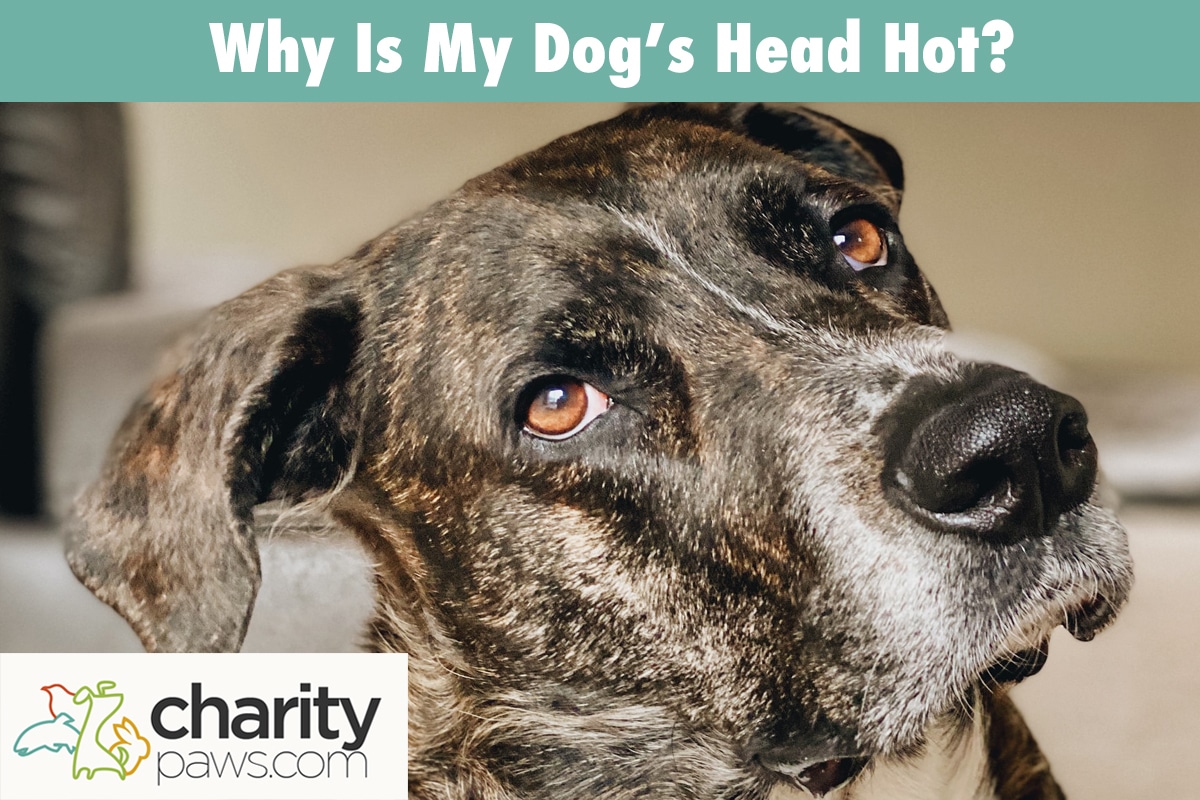There are many reasons why a dog’s head can feel hot, and it can be concerning when you are unsure what caused it.
Some of the most common culprits include fever, heatstroke, vaccination, stress, allergies and inflammation.
There are also circumstances in which your pet’s head can feel hot that are not a cause for concern.
5 Reasons Why Your Dog’s Head Is Hot

Your Dog Has A Fever
One reason a dog’s head may feel warm to the touch is a fever.
Just like in people, dogs’ bodies also have a natural immune response to bacteria and other infectious organisms that lead to an elevation in temperature.
The body does this in an effort to kill off whatever is causing the infection.
This particularly applies to bacteria and viruses, as they have a harder time thriving in higher-temperature environments.
Symptoms of an elevated temperature in canines may include:
- Eye Redness
- Low Energy
- Increased Sleeping or Resting
- Hot ears, nose, and belly
- Trembling
- Decreased Appetite
- Vomiting
The most accurate way to determine if your furry friend has a fever is by taking a rectal temperature.
This can be done using a regular digital thermometer, applying a bit of petroleum jelly to the tip of the device, and carefully inserting it just enough so that the metal part of the tip is inside.
Turn it on and wait for the thermometer to beep before gently removing it.
A dog’s normal temperature ranges from 101 to 102.5 degrees Fahrenheit.
Anything above 102.5 is considered a fever.
As to the exact cause of a fever in canines, only a vet can give a diagnosis and provide proper treatment, as an infection can be caused by a myriad of bacteria, viruses, parasites, and even intoxication from the ingestion of plants, chemicals, and other substances that are toxic to dogs.
Your Dog Has Heatstroke
The second potential reason for a dog’s head feeling hot is heatstroke.
Unlike humans, dogs do not have the ability to sweat, at least not fully.
They do sweat a little through their sweat glands in their paws, but the main way that they cool off is by panting.
While panting can keep them cool most of the time, there are instances when it may not be enough, and this is when overheating occurs.
Some situations that can end in heatstroke include being in a hot car, exercising or playing out in the heat, and overdoing physical activities.
A hot head may very well be a sign of heat exhaustion, as the entire body’s temperature tends to increase.
Other signs of heatstroke in dogs:
- Rapid breathing and panting excessively. Dogs with shorter faces such as bulldogs, pekingese, and pugs are more prone to heatstroke due to their inability to pant as well as other breeds
- Vomiting
- Dry/sticky gums caused by dehydration.
- Drooling
- Purple tongue, bright red gums, or bruises on the gums that appear as red patches or dots
- Dizziness or disorientation, often exhibited by walking around in no specific direction, bumping into things, and not responding to verbal cues as usual
- Trembling only in some muscles or all over the body
- Weakness, which can show up as not being able to get up or having issues with balance
- In more severe cases, or when left untreated, heatstroke can also cause sudden collapse and seizures
Heat exhaustion is a very serious condition that requires immediate veterinary attention.
If possible, have someone else call the vet for instructions.
In the meantime, there are some things that you can do to help your pet.
If you suspect that your pup may be overheated, the first thing you should do is quickly move them away from the source of heat.
If they are outdoors, and it is cooler inside, bring them indoors.
Then get some room-temperature water and pour it over the dog’s entire body.
The water should not be very cold, as going from extreme heat to extreme cold can cause dogs to go into shock.
What you can do is gradually make the water cooler by mixing in some ice cubes while continuously pouring it over the dog.
You can also wrap some ice packs in a towel and apply them to the dog’s head, underarms, and belly.
Offering some cool water for your dog to drink is also a good idea.
Sometimes it’s possible for the veterinarian to bring your dog’s temperature down to normal without the need for hospitalization, but it may be necessary.
Hospitalization allows vets to give intravenous fluids and medication as well as monitor your dog closely until they have fully recovered and are ready to go home.
Your Dog Recently Had Vaccinations
If vaccination has taken place within the past 48 hours, and your pup is feeling warm to the touch, it is very likely that it is just a normal reaction to the immunization.
Most dogs will develop a slight fever a couple of hours after being vaccinated.
Soreness at the site of injection, sleepiness and a reduced appetite are other common side effects of vaccines.
It isn’t something that you need to worry about as long as there are no other accompanying symptoms that may indicate an allergic reaction, it does not get worse, and it does not last for more than two days.
Your Dog Is Stressed
Mental disturbances such as stress and anxiety can also manifest physically in canines.
This can include fast, labored breathing and pacing back and forth, both of which increases a dog’s body temperature and causes their head to feel warm.
Stress can be brought on by a change in the daily routine, introduction of a new pet or person to the family, being left alone for prolonged periods, going to the vet, and staying at a boarding facility.
Stress and anxiety is also common in recently adopted dogs because they are in a new place, with new people, and are uncertain of what their new life is all about.
Some dogs may also develop PTSD after traumatic situations.
This can be anything from being physically abused to being exposed to fireworks or having a traumatic experience at the vet.
Stress doesn’t always indicate trouble though.
It is also the body’s own way of dealing with danger and protecting itself.
However, if it is something that doesn’t go away, you may want to look into what is causing the stress or anxiety and remove it from the pup’s habitat.
Be careful not to overly comfort your dog, as this can further encourage the behavior.
What you can do is introduce some routine activities such as giving out commands, going out for exercise, and so on.
Keeping a routine can help dogs return to feeling safe and comfortable with their environment.
Your Dog Has Allergies
Allergies frequently bring about severe itching, which lead dogs to scratch the affected area.
The friction from the itching then generates heat, and if they are scratching their head, face, or ears, this can then make the skin in that area feel warmer than usual.
Additional signs of skin allergies in canines include:
- Dry and flaky skin
- Dull Coat
- Hair loss or bald spots and shedding more than usual
There is no cure for allergies, but the positive side of this is that it the condition can be managed.
A veterinarian can help you pinpoint what exactly triggers the allergies in your dog and provide you with a plan to minimize the exposure that your dog has to these things.
Medication such as antihistamines are also commonly prescribed.
Inflammation is another possible cause for a warm head in dogs.
This can be swelling from an injury to the head, an infected wound or abscess, or even an ear infection.
Once the underlying cause of your dog’s hot head is diagnosed, then the issue can be resolved with treatment.
Harmless Reasons Why A Dog’s Head May Feel Hot

In many cases, a warm head in a dog may just be due to normal circumstances such as being in a warmer environment.
Your dog may have been sleeping close to the heater or fireplace, resting on warm cement, sunbathing in the yard, or even digging themselves into a warm hole and lying in it, all without you being aware of it.
When you go to pet them and notice the warmth on their head, it can be quite alarming if you don’t have an idea as to what caused it.
That’s why it’s important to consider the circumstances and see if you can figure out what your dog was doing beforehand.
You may also want to observe your furry friend and keep an eye out for any other unusual symptoms that may indicate a bigger issue.
Remember, if in doubt, it’s always safer to call your vet and ask if an exam is in order.
They will either reassure you that it’s nothing to worry about or have you bring your dog into the office.

